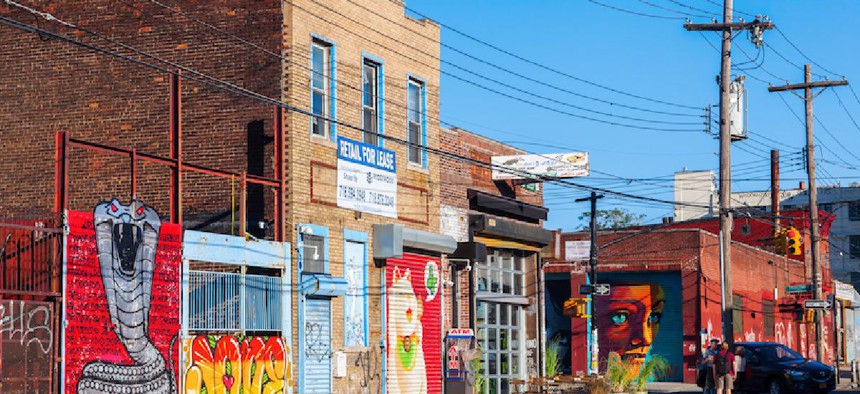The geography of art and culture in New York City has changed profoundly over the past two decades. Soaring rents have pushed artists to disperse, with studios, galleries, music venues, and performing art spaces opening throughout the five boroughs. This shift is most evident in Brooklyn, where the number of visual and performing artists increased 63 percent since 2000 and the number of cultural nonprofits grew 151 percent in the past decade. City funding, however, has not kept pace.
In 2015, Brooklyn received just 16.6 percent of grant funding handed out by the New York City Department of Cultural Affairs. This is down from 17.3 percent in 2011. Despite its increased prominence in the city’s arts scene, Brooklyn was the only borough to experience a decline in cultural funding between 2011 and 2015.
Understandably, Manhattan receives the bulk of cultural affairs funding. It is home to 48 percent of the city’s artists and 67 percent of its cultural organizations, including many world-class institutions that serve residents throughout the city and tourists throughout the world.
But Brooklyn, which has 30 percent of the city’s artists, receives a smaller share of cultural affairs grant funding than both Manhattan (53.6 percent) and the Bronx (17.9 percent). And while Brooklyn is home to 49 percent of the cultural organizations in the boroughs outside of Manhattan (706 out of 1,450), it receives only 36 percent of cultural affairs funding for these boroughs.
![]() Click to enlarge
Click to enlarge
Brooklyn is disadvantaged by a funding process in which small organizations and individual artists receive a fraction of the total pie. To be sure, DCLA is the most generous arts funder in the country, providing roughly $140 million in grants to cultural organizations – an amount that will soon rise thanks to a $10 million increase in this year’s city budget. But the bulk of the total goes to the 33 members of the city’s Cultural Institutions Group, organizations that operate on city owned land. For instance, the ten Cultural Institutions Groups in the Bronx and Staten Island received $28.4 million, compared to $17.4 million for Brooklyn’s five.
There are clear reasons why these group members receive a disproportionate share of city funds. Institutions like The Met, Bronx Botanical Gardens, and Brooklyn Academy of Music attract visitors from across the nation, draw the best performers in the world, and, given their scale, cost millions of dollars to maintain.
But it’s time to rethink the funding process. Although the Department of Cultural Affairs has strongly advocated for equity in the arts, the agency's granting programs could do more to bolster individual artists and small organizations throughout the five boroughs.
Small and midsize art spaces, immigrant-focused cultural organizations, and individual artists have been hit the hardest by rising rents and the decline in government funding, particularly at the state and national level. Absent the resources that larger institutions enjoy, many of these artists and arts organizations are struggling to survive in New York City.
With the recent $10 million increase in the cultural budget and next year’s release of the Cultural Plan, the de Blasio administration is clearly intent on addressing these issues. To promote affordability, equity and diversity in the New York arts ecosystem, the plan should consider the following recommendations.
First, the city should support the use of nontraditional venues for artist studio and rehearsal space, including schools, spiritual institutions, and libraries. In public school buildings, there are 1,388 visual arts rooms, 1,242 music rooms, 924 auditoriums, and 476 dance studios. Most remain empty two-thirds of the day. The Department of Education should allow for cultural non-profits and individual artists to utilize these school spaces at affordable rates.
Additionally, the city should continue to use its zoning authority to secure affordable cultural and studio spaces for artisans and artists. In Harlem, for instance, development bonuses are provided to buildings with nonprofit visual or performing arts spaces on their ground floors. Last month, the Brooklyn Borough President’s office recommended just this for an application for 141 Willoughby Avenue in downtown Brooklyn.
The city should also continue to increase the Department of Cultural Affairs budget and provide operating support to the small organizations and individual artists who are most in need. To fund this budget boost, the city could follow the lead of San Francisco and San Diego and allocate a portion of its hotel room occupancy tax toward cultural grant making. Given that New York City’s arts organizations help drive tourism and fill hotels, a portion of these revenues should circulate back to them.
These recommendations can help alleviate the affordability crisis facing New York City’s artists and arts organizations. With a more targeted, equitable, and generous cultural funding strategy, the city can continue to cultivate artistic talent and support diverse creative communities across all five boroughs.
Eric Adams is the Brooklyn borough president. Adam Forman is a senior researcher at the Center for Urban Future and has authored several reports for the Center on topics ranging from the arts economy to city infrastructure.



